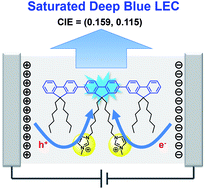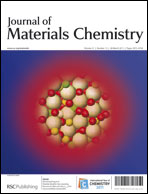An ionic terfluorene derivative for saturated deep-blue solid state light-emitting electrochemical cells†
Abstract
In this study, we obtained saturated deep-blue electroluminescence (EL) from solid state light-emitting electrochemical cells (LECs) incorporating the ionic terfluorene derivative 1, which we synthesized through covalent tethering of methylimidazolium moieties as pendent groups of terfluorene. Compound 1 exhibited the deep-blue emission, extremely high quantum yield, and reversible redox behavior that are characteristic of terfluorene derivatives. LEC devices incorporating terfluorene 1 exhibited deep-blue EL with CIE coordinates of (0.159, 0.115) and (0.151, 0.122) in the absence and presence, respectively, of the


 Please wait while we load your content...
Please wait while we load your content...